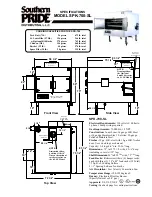
KIN Architectural
INSTALLATION
1-Use the provided template to trace a rectangle in pencil for the intended location.
TIP:
Make a small hole in the center of the outline. Use approximately 1’ (30cm) of coat hanger
wire and bend it to a right angle in the middle. Insert in the hole and rotate to check for wires,
pipes, studs or other obstructions.
2-Carefully cut out the speaker cavity with a drywall saw or similar tool. Remove the cutaway
and lightly compress the insulation, if any.
3-Fish the speaker cable from the amplifier and out through the recently cut speaker cavity.
Allow yourself at least 1’ (30cm) of slack to protrude to facilitate the installation. Strip 3/8”
(1cm) off the ends of the speaker wires and connect to the speaker terminals. Note: Make sure
to respect polarity of the wire, connecting the negative and positive leads to the right inputs.
4-Ensure the “Dog Ears” are in their original position, flush set within the
frame, and insert the speaker in the wall or ceiling. Gradually tighten the
Philips screws on the speaker frame to fix the speaker in place. They can
handle strong torque settings, but ideally lower torque setting should be used
to prevent accidents and ensure a proper installation. Textured terminals
provide extra grip on any material, guaranteeing a solid, tight installation.
5- Place grille on speakers to complete the
installation.
PAINTING THE GRILLS
The stainless steels grilles can be painted to suit personal tastes
and match aspects of the décor. The grill incorporates a scrim-
cloth to hide the drivers when installed. This scrim-cloth is adhered
to the grill with a light adhesive and must be removed before
painting but maintains its adhesion qualities and will reattach once
painted. To remove it, gently peel from the small tab
inconspicuously located along the trim. Ideally the process would
be done with spray paint or a spray gun set to a low setting which
lessens the chance of plugging the holes. After the paint is dry, re-
apply the scrim-cloth.


























